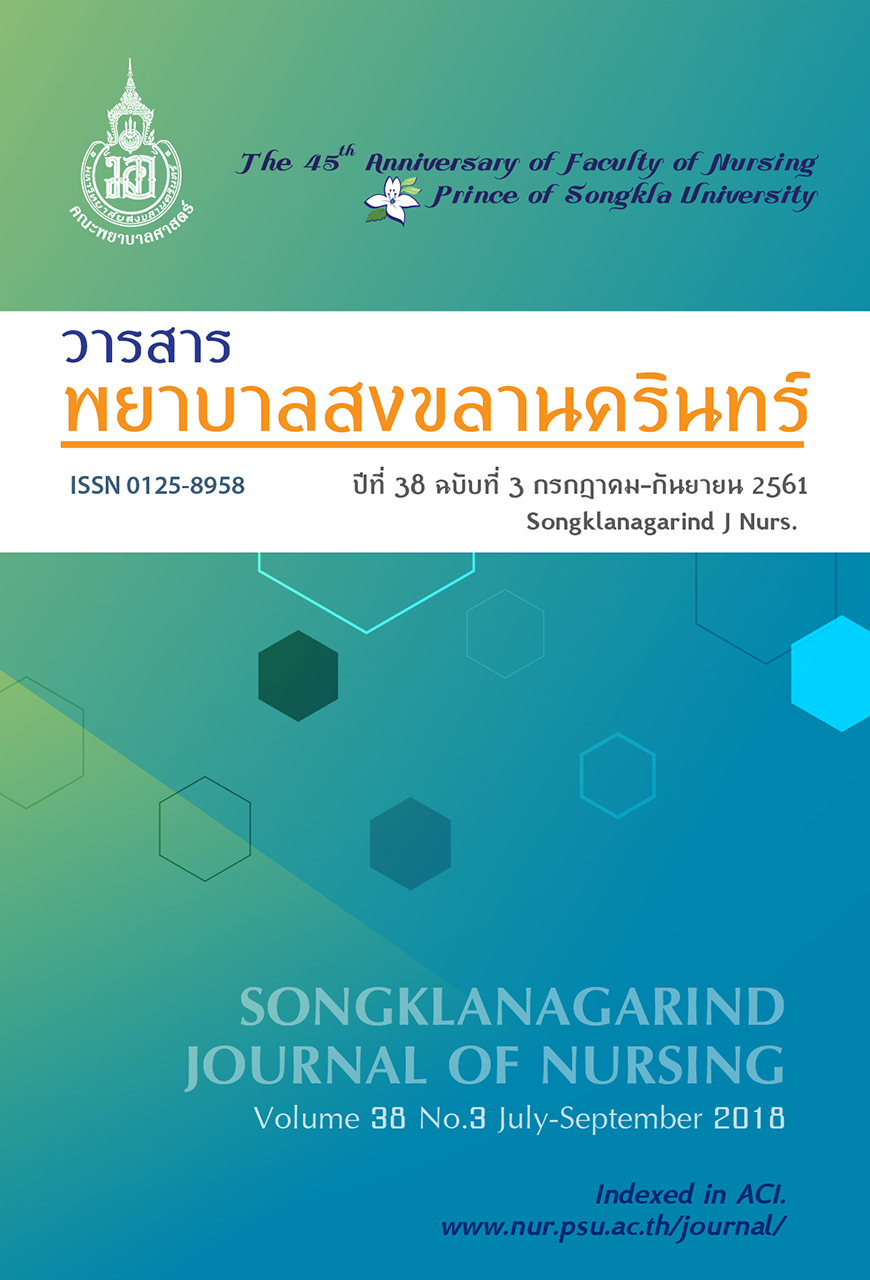Endotracheal Suctioning in Patients with Severe Traumatic Brain Injury
Main Article Content
Abstract
Endotracheal suctioning (ETS) is an essential nursing activity to maintain a patent airway and avoid
accumulation of secretions in pulmonary tract. It is required for patients with severe traumatic brain injury
(sTBI) to preventing hypoxia that lead to secondary cerebral injury. However, ETS is associated with adverse
effects in both children and adults with severe TBI. The nursing procedures including suctioning with manual
hyperinflation, promoting cough, hyperventilation, duration of suctioning, and ineffective pain management
during ETS effect on cerebral perfusion pressure (CPP), mean arterial pressure (MAP), and intracranial
pressure (ICP). Therefore the appropriate and competent suctioning technique of pediatric and adult intensive
care nurse is important in minimizing risk and adverse events.
Article Details
References
2. Kim Young-Ju. A systematic review of factorscontributing to outcomes in patients with traumatic brain injury [Internet]. J Clin Nurs. 2011; 20 (11/12):1518–32 [cited 2018 Jun 4]. Available from: https://doi.org/10.1111/j.1365-2702.2010.03618.x
3. Tume L. Impact of care interventions on childrenwith severe traumatic brain injury in intensive care. Br J Neurosci Nurs. 2008; 4(4): 151-5.
4. Mavin C. Types and causes of head injury: An overview. Br J Neurosci Nurs. 2008; 4(10): 488-90.
5. Sole M L, Klein D G, Moseley M J. Introduction to critical care nursing. 6 th ed. St.Louis: lsevier Saunders; 2013.
6. Tume L N. The nursing management of childrenwith severe traumatic brain injury and raised ICP clinical. Br J Neurosci Nurs. 2007;3(10):461-7.
7. Ponglaohapun U, Wongwatunyu S, Khuwatsamrit K. Nursing activities and factors related toincreased intracranial pressure in head injured patients. Rama Nurs J. 2009; 15(2): 221-32. Thai.
8. Tume L, Jinks A. Endotracheal suctioning in children with severe traumatic brain injury: A literature review. Nurs Crit Care. 2008; 13(5): 233-8.
9. Puttiwanit S, Puttiwanit N, Kliangprom J. Evidencbases practice on endotracheal suctioning for intubated adult patients. NJPH. 2017; 27(3):10-8. Thai.
10. Morrow B M, Argent A C. A comprehensive review of pediatric endotracheal suctioning: Effects, indications, and clinical Practice. Pediatr Crit Care Med. 2008; 9(5): 465-77.
11. Bunburaphong T. Respiratory care in clinical practice. 3 rd th. Bangkok.: Cho Raka Printing; 2012.Thai.
12. Baun M M, Stone K S, Rogge J A. Endotracheal suctioning: Open versus closed with and without positive end-expiratory pressure. Crit Care Nurs Q. 2002;25(2): 13–26.
13. Ounnapiruk L, et al. Pathophysiological in nursing. 9 th ed. Bangkok: Boonsiri printing; 2012. Thai.
14. Pedersen C M, et al. Endotracheal suctioning ofthe adult intubated patient-What is the evidence?. Intensive Crit Care Nurs. 2009; 25: 21-30.
15. Ross P M, Steven D, Miriam M T. Targeting brain tissue oxygenation in traumatic brain injury. Respir Care. 2013;58(1):162-72.
16. Humphries L. How to dodge the dangers of deep suctioning. RN. 2005; 68(9): 60-1.
17. Wang C, et al. Normal saline instillation before suctioning: A meta-analysis of randomized controlled trials. Aust Crit Care. 2017; 30: 260-5.
18. Ridling DA, Martin LD, Bratton SL. Endo-tracheal suctioning with or without instillation of isotonic sodium chloride solutionin critically ill children. Am J Crit Care. 2003; 12: 212-9.
19. Punjaisee S, Phuenpathom N, Veerasarn K. Clinical practice guidelines for traumatic brain injury. Bangkok: Tanapress; 2013.Thai.20. American associate respiratory care. AARC clinical practice guideline: Endotracheal suctioning of mechanically ventilated patients with artificial airways. Respir Care. 2010;55(6):758-64.
21. Javidi M, Hejr H, Zolad M, Khalili A, Paymard A. Comparing the effect of endotracheal tube suction using open method with two different size catheters 12 and 14 on secretion ,pain, heart rate, blood pressure, and arterial oxygen saturation of patients in the intensive care unit: A randomized clinical trial. Ann Trop Med Pub Health. 2017; 10(5): 1312-7.
22. Chaiweeradet M, Ua-Kit N, Oumtanee A. Experiences of being an adult patient receiving mechanical ventilator. Songklanagarind J Nurs. 2013; 33(2): 31-45. Thai.
23. Kawthaisong W, Punthmatharith B, Wiroonpanich W. Experiences of school-aged children receiving mechanical ventilation. Songklanagarind J Nurs. 2016; 36(supp): 117-31. Thai.
24. Rahu M A, et al. Facial expression as an indicator of pain in critically ill intubated adult during endotracheal suctioning. Am J Crit Care. 2013; 22(5): 412-22.
25. Tume L. Impact of care interventions on childrenwith severe traumatic brain injury in intensive care. Br J Neurosci Nurs. 2008; 4(4): 151-5.


